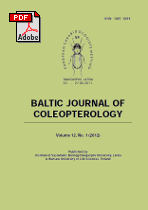Stable isotopic research on ground beetles. Review of methods
Main Article Content
Abstrakt
Stable isotope signals of nitrogen (δ<SUP>15</SUP>N) or carbon (δ<SUP>13</SUP>C) are becoming very important tools in ecology allowing investigations of animal diets and food webs. The method proved to be particularly useful in investigating secretive animals e.g. insects. Here we review methods used in stable isotope studies on the model taxon - ground beetles. A review of 50 publications quoting stable isotopes and Carabidae (only 18 publications contained relevant information) shows that stable isotopes are used to solve a variety of ecological questions and that the method is particularly popular among Japanese ecologists. While some of laboratory procedures are becoming standards, other important issues e.g. desired sample size or way of measuring isotopic baselines, remain unsolved. We additionally present results of a limited experiment on the effect of preservatives on isotopic signals. Our experiment shows that a seven-day storage in monoethylene glycol followed by a seven-day storage in 96% ethanol does not affect the δ<SUP>15</SUP>N and δ<SUP>13</SUP>C of ground beetles. All together, the review of the methods and experiments point to the conclusion that standard methods used in research on ground beetles are well-suited to stable isotope methodology. We conclude that the stable isotope method is likely to solve key questions that used to capture the attention of ecologists studying ground beetles.
Article Details
Statystyki
Downloads
Download data is not yet available.
Rekomendowane teksty
